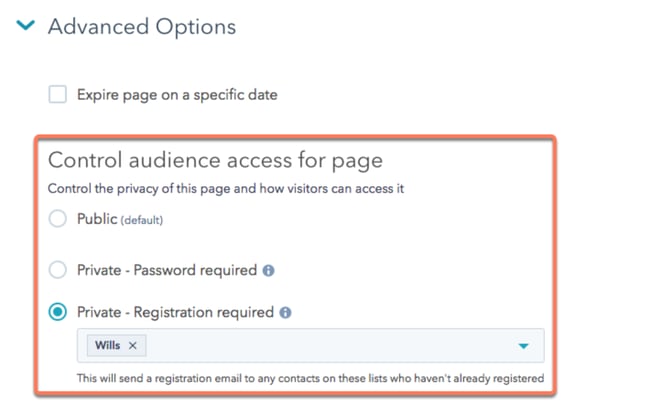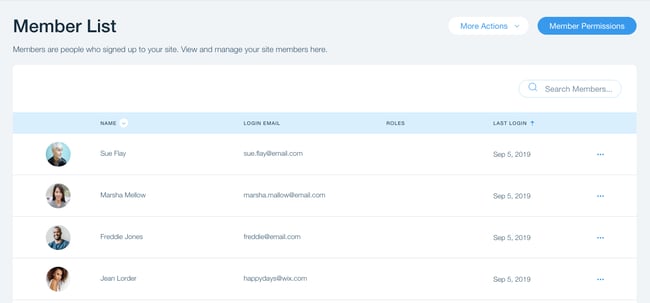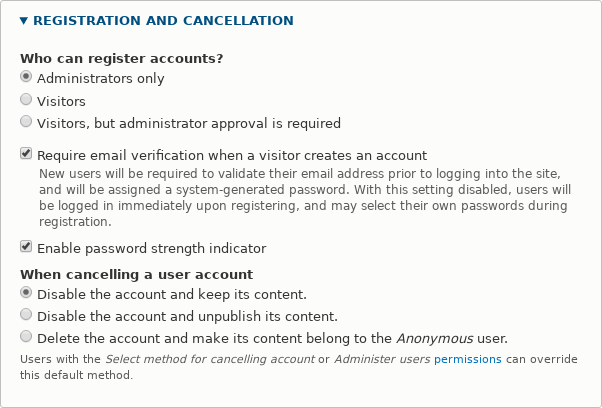How To Get Users To Register On Your Site
When visitors come up to your website for the first time, they're not only looking to learn nearly your product. Ultimately, they're here to determine whether choosing your business organization is worth their fourth dimension, money, and free energy. For this reason, converting customers online requires more than just an attention-grabbing production description and a sleek homepage — your website needs to engage visitors with an excellent feel. One popular way to provide such an experience is with user accounts. Adding a user account characteristic might be a major change to your site's structure and functionality. Fortunately, today's website edifice software makes this possible in merely a few clicks. In this article, I'll explicate how to enable user accounts and profiles on 6 popular content management systems: CMS Hub, WordPress, Joomla, Wix, Drupal, and Shopify. With a user account, a visitor creates a personalized contour on your website in club to tailor their experience with your web content. Accounts empower users to access exclusive offers, contribute to a community of swain customers, reach out to customer support, and receive content recommendations relevant to them. All of these benefits help you gain consumer trust and catechumen visitors into engaged leads. Afterwards all, they're called "user accounts," not "company accounts." Many sites can gain from providing user accounts, regardless of the product or industry. If your website... ...then you'll likely need user accounts on your website. But before you continue, consider whether information technology's best for your specific site to suggest or require accounts. An account should showtime and foremost raise the user experience, so make sure the benefits to the customer are worth the fourth dimension and effort of signing upward. No one should feel "forced" to create an account when they don't need to. This is the general process for making a website with user accounts and profiles, no affair what CMS or website builder yous utilise. Below we'll accept a closer look at the process for vi of the nigh pop platforms. If you oasis't created a website yet, then y'all have a choice between two types of softwares. For the simplest approach to making an account-based website, choose a website builder that specializes in membership sites. Run into our listing of thebest membership website builders and platformsfor recommendations for this blazon of service. If you've already congenital a website using a CMS, you can hands add user accounts, too. In nigh cases, the CMS handles the functionality of a membership site for you, either by itself or with an addition. A user business relationship tool should introduce features for registration, login, contour customization, and restricting content to only certain registrants. CMS Hub is HubSpot's content management system. CMS Hub fully integrates with HubSpot CRM and HubSpot's marketing, sales, and service tools. With an Enterprise account, you can limit access to website pages, landing pages, and weblog content by contact listing. Afterwards restricting a page to selected lists, contacts on these lists will be notified via e-mail to register. To set up membership registration for a page in CMS Hub: Image Source For a full guide to managing user access on your HubSpot-powered website and blog, run across our knowledge base article on membership registration with CMS Hub. To enable user membership on your WordPress site, a plugin is needed. There are many reputable options for WordPress website account management — here are some we recommend: They might have similar names, but be sure to consider how each plugin fits your specific needs and budget. For more than WordPress plugin recommendations and some first-class examples of membership sites built with WordPress, run into our guide to creating a WordPress membership site. To activate user accounts on your Joomla site: Paradigm Source You can too toggle how to confirm membership through electronic mail confirmation or administrator approval. For more detailed instructions on enabling user registration with Joomla, see Joomla'south user documentation. Wix lets administrators activate user accounts with the Members Area feature, bachelor with whatsoever Wix plan. With a Members Area set up on your Wix site, visitors tin can annals and view exclusive content on fellow member pages, and administrators can easily view and manage their site members. Image Source This tool is designed for easy setup, and integrates with add together-on applications for chat, blogging, events, due east-commerce, and more. Acquire how to set up a Members Area on Wix's support site. If you want to restrict access to content without setting up a Members Area, yous can set admission to specific pages based on member roles or make pages exclusive to paid members simply. Drupal lets site administrators create roles for different visitors. These roles grant different permissions for viewing and creating website content. Drupal creates three roles past default: In Drupal core, you can also add together additional roles specific for whoever may come up to your website, and assign permissions to these roles. For example, a blog site might have a "writer" role for visitors with permission to create and publish content. To configure who can create accounts on your Drupal site and customize the registration and counterfoil processes: Image Source For more circuitous membership site functions, Drupal relies on third-party modules. Select a well-maintained, reputable Drupal module like Membership, Drupal Commerce, and/or Rules for more than hands-on control over your membership site. For guidance on installing these modules, see Drupal's instructions. To enable customer accounts in Shopify: For more help editing customer account settings on your Shopify site, including how to alter your site settings on a mobile device, see Shopify'southward help folio. Once you lot've set up user registration with a built-in feature or plugin, yous'll need to create a registration form. This type of form will enable visitors to create a user account by filling out some bones information, like their proper noun, email address, and a password. Adjacent, you'll need to create a login page where users tin can log in afterward they've registered. The full general process is outlined below, but the exact steps volition depend on what CMS or website builder yous utilize. Some website builders and content direction systems have congenital-in class builders, while others require a plugin. Whatever tool you're using, you lot desire to create a login course that provides a good user feel. Some best practices to consider are accepting login alternatives like an email address or phone number, adding a clear "Forgot password?" link, and alarm users when Caps Lock is on. Next, y'all need to create the folio where you lot'll embed the login form. This volition become your login page. A login page should exist elementary and consistent with your branding. Once you've created your login page, embed the login class. This process is relatively simple on any CMS or website builder. For instance, here's what the process looks like in CMS Hub: You lot can then customize the course's settings and the login page until you're happy with its design and functionality. The effect should be equally simple and sleek as Facebook's login folio and form. After setting up user accounts on your website and creating a login page, be sure to exam the user registration process on your site. Accept yourself and others create test accounts on your website. Modify your test account profiles, change their permissions, and bank check that exclusive content is actually set to sectional. If your website is already online, consider setting information technology to maintenance manner while testing these changes. Temporarily hiding your site prevents any complications from new signups in this phase. Some other pick is to create a staging site where you lot tin can freely experiment with user accounts, while your alive site stays untouched. During this testing phase, you'll want to check on the following: Did you receive a confirmation electronic mail upon signing up? If not, you'll want to ensure you've fix that up. Your CMS platform may either provide an option to send a confirmation electronic mail or yous can install a plugin or extension that gives you the choice. Exam the workflow a user would accept when irresolute their countersign. If you don't receive a password change link in a timely manner, something may have gone amiss during activation. You also desire to take a look at the password modify email to ensure it aligns with your brand both in verbiage and pattern. A member area may be uncomplicated, or it may exist more elaborate depending on the nature of your website. Double-check that it looks right and that it offers all the options a user needs. If yous're an ecommerce make, ensure there are options to view previous orders, alter menu information, and found their aircraft address. Examination for mobile-responsiveness as well. If buttons are cut off or users tin't get to sure sections, y'all'll desire to tinker with the design of the membership area. We've touched upon this briefly, but brand sure all exclusive content is truly exclusive to your users. If you're planning to distribute exclusive PDFs and documents, mark them with robots.txt files or noindex, nofollow meta tags so that search engines don't crawl them, and unregistered users can't find them via a site search. As an owner of a website where people give yous access to their contact and card information, y'all'll want to ensure yous have a privacy policy that protects these users from abuse. Fifty-fifty if you already have a privacy policy, you'll need to update it to reflect your new user department. To get started, use a privacy policy generator such every bit Termsfeed, Termly.io, or Shopify'southward. If you don't already have one, invest in an SSL certificate to ensure your website is every bit secure as possible. If you lot're not sure if you lot have one, use an SSL checker. This certificate changes your internet protocol from HTTP to HTTPS. In some browsers, there will be a padlock next to your URL, signifying that all the information users share with y'all will be kept individual. Now that nosotros've covered how to set up upward user accounts and profiles, how to create a login page, and how to test user accounts, permit'southward recap what yous'll need to make a website with user accounts and profiles: Whether you're running an online store, building loyalty through a membership site, or providing a domicile for user content with a hosting service, user accounts empower your visitors to stay engaged with your premium content and features, and help you to keep track of your customer base as it continues to abound. No thing the CMS, you're covered. Editor'due south note: This mail service was originally published in June 2020 and has been updated for comprehensiveness. 
Why Create a Website With User Accounts?
How to Make a Website With User Accounts and Profiles
CMS Hub

WordPress
Joomla

Wix

Drupal

Shopify
How to Create a Login Page for My Website
ane. Create a login form using a course builder.
ii. Create a login folio.
iii. Embed the login grade on the login page.

Test Your New User Accounts
Sign-Upwardly Confirmation Email
Countersign Change Workflow
Member Area Blueprint
Exclusive Offers
Privacy Policies and Terms of Utilise
SSL Certificate
Things Yous'll Need to to Make a Website with User Logins
Grow Your Website with User Profiles


Originally published Nov 23, 2021 7:00:00 AM, updated November 23 2021
Source: https://blog.hubspot.com/website/make-website-with-user-accounts
Posted by: bazemoreonsationg.blogspot.com


0 Response to "How To Get Users To Register On Your Site"
Post a Comment